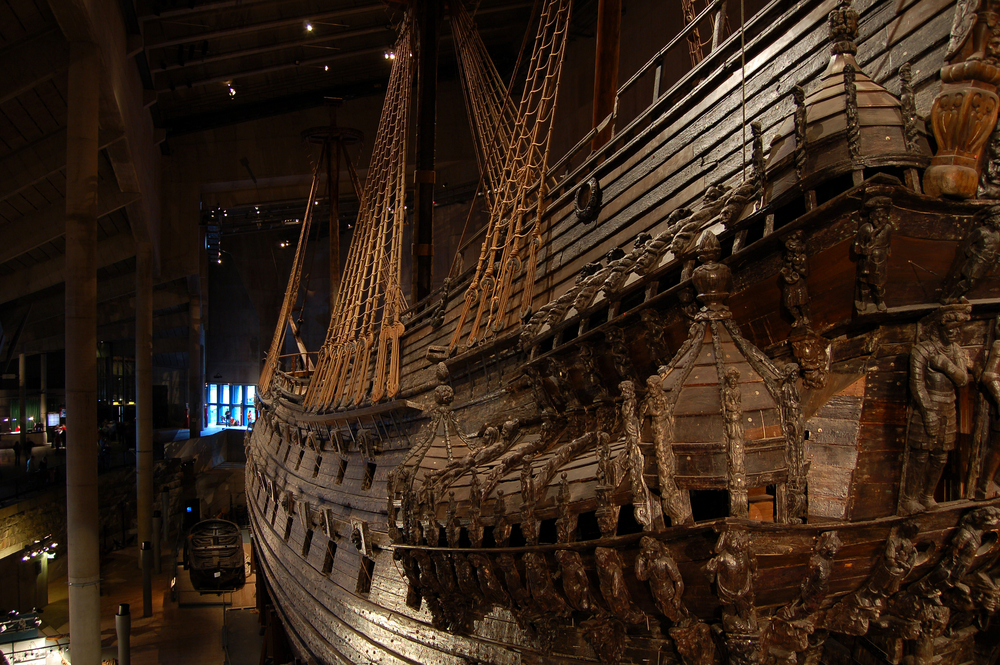The Vasa Warship Sank After Only 25 Minutes of Sailing, Taking 30 Lives With it

On August 10, 1628, Vasa, the would-be jewel of Sweden’s navy sank only minutes after departing Stockholm. This tragedy – that claimed the lives of 30 of those on board – launched an inquest probing how the hulking 64-cannon ship met such an shameful end.
Since the ship still exists almost in its entirety – held at a dedicated museum near Stockholm – we know that investigation was largely correct in its findings.
The Sinking of the Swedish Warship
On the day itself, Vasa set sail on calm waters. Around 20 minutes into its maiden voyage the ship leaned – or heeled in nautical terms – to its port side after a gust of wind. Another gust tipped the boat even more, causing water to wash in through the gun ports. Shortly after, Vasa toppled and sank.
Initially, suspicion fell upon the captain and the crew. That included questions about their competence in tying down the guns and whether they were drunk when they set sailed. There’s no firm evidence if drinking was involved, but the accusations were denied, says Christin Simons, a lead guide at the Vasa Museum in Sweden. As for the cannons, when the ship was raised in 1961, the cannons remained in place.
Read More: 4 Famous Shipwrecks That You Can Visit
Why Did the Vasa Sink?
Investigators quickly concluded that the fault lay with the design and build of the ship, Simons says.
“The shipbuilder had conveniently died the year before the sinking, so he had to take the entire blame; a perfect scapegoat,” she says.
The crew did see warning signs the day before the tragedy when they carried out a simple test of its seaworthiness, says Simons.
While docked, 30 men ran from one side of the deck to the other repeatedly to make the ship roll. Evidently, it rolled so much that there were fears it would tip there and then in the port, says Simons, so they stopped.
“Vasa was way too heavy for a ship with two-gun decks,” Simons explains, adding that usually a two-deck ship would have a heavier one on the bottom and lighter gun deck on top; Vasa had two decks of equal size and weight.
That meant the massive ship simply was far from seaworthy. At the time of the inquest several experts in shipbuilding pointed out that Vasa didn’t have enough belly to support all those one and a half ton cannons, not to mention the crew and other gear. So, the responsibility for the ship’s sinking traced all the way back to its design and construction.
Read More: The $20 Billion Treasures of the San José Wreck Will Soon Be Saved
A Would-Be Powerful Ship
In total, Vasa managed to sail for only 25 minutes, foundering less than a mile. Ultimately, nobody was punished for the whole affair, despite the furious King of Sweden’s demands that someone be held accountable.
Had its launch succeeded, Vasa may well have been the most powerful warship in the world at that time. It could have played a role in the ensuing 30-year’s war that ravaged Europe, and which Sweden would shortly enter after it sank in 1630.
Alas, that wasn’t to be. Instead, it is one of Sweden’s most popular tourist destinations. “She’s actually quite unique in the entire world, because Vasa is 98 percent original,” Simons says. “There is no other ship that we know of in the world that is from the 17th century that is so well preserved.”
Vasa’s recovery in the 1960s has allowed a glimpse of life into Swedish sailors in the 17th century, says Simons.
“It is a ship frozen in time,” Simons, who is also an archaeologist, says. “She sunk with everything still on board, and that means we have a lot of histories, or traces of histories, of people that were usually not in the historical record.”
But the race is on to save the salvaged ship as it’s still in the process of drying out, meaning that the aged wooden structure is shrinking in on itself.
“Soon Vasa will not be able to support her own structure any longer. So now we’re setting a steel skeleton into the ship to support her from the inside,” says Simons.
Article Sources
Our writers at Discovermagazine.com use peer-reviewed studies and high-quality sources for our articles, and our editors review for scientific accuracy and editorial standards. Review the sources used below for this article:
Sean Mowbray is a freelance writer based in Scotland. He covers the environment, archaeology, and general science topics. His work has also appeared in outlets such as Mongabay, New Scientist, Hakai Magazine, Ancient History Magazine, and others.
